MEMORIES
AND INFORMATION - SHROPSHIRE
1st
SALOP (SHREWSBURY) BATTN.
and
GLYN
ROWLANDS
This
is a page within the www.staffshomeguard.co.uk website.
To
see full contents, go to
SITE
MAP.
|
There appeared in the Shropshire Star
in March 2006 an informative and entertaining article by
Toby Neal, based on the reminiscences of Mr. Glyn Rowlands
of Welshpool. This article, expanded to include further
quotations subsequently received from Mr. Rowlands, is reproduced
below. We are indebted to the Shropshire Star for permission
to publish it on this website and make full acknowledgement
to the newspaper, to Mr. Rowlands and his family and to Mr Neal.
"THREE
SHELLS TO SAVE TOWN"
Had the Germans invaded
in World War Two, Glyn Rowlands would have been one of Shrewsbury's
brave defenders. As German tanks advanced on the town's
northern perimeter, Mr. Rowlands would have grabbed a Blacker
Bombard anti-tank weapon, loaded it up in the square carrier
on the front of his father's bicycle, and pedalled to its
firing position at the junction of
Berwick Road. But as
he only had three anti-tank projectiles, he would have been
in a spot of bother if the Germans
were attacking with four or more tanks.
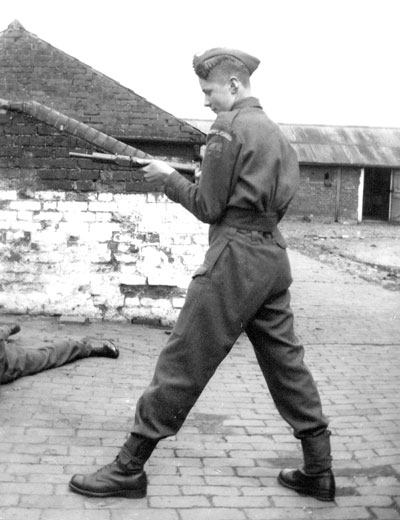 For Mr. Rowlands
(pictured
right, in April 1943) the memories of his days
in the Home Guard all came flooding back when he visited
a "Shropshire At War" exhibition at St Mary's
Church, Shrewsbury, in January 2006. For Mr. Rowlands
(pictured
right, in April 1943) the memories of his days
in the Home Guard all came flooding back when he visited
a "Shropshire At War" exhibition at St Mary's
Church, Shrewsbury, in January 2006.
"I had
intended to write about the Home Guard for some time, but
as my memory is starting to fade I thought the time was
now opportune. The booklet and exhibits were a spur."
He later lived in
Welshpool,
but on September 3rd, 1939, he was a 13-year-old choirboy
at St Mary's Church in
Shrewsbury. There was, he recalls,
a large congregation that day, with few vacant pews.
"We knew that the
world news was not very good. Just after 11 a.m. Eucharist
began and I saw the verger, Mr Hordley, walk down the
aisle and hand the vicar, the Rev R.M.B. MacKenzie,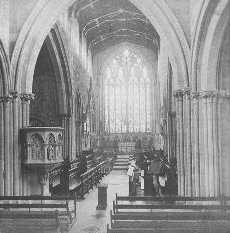 a piece of paper. He read it and walked over and climbed
the pulpit steps. On reaching the top of the stairs he
paused momentarily and then announced solemnly that Great
Britain was at war with Germany.
a piece of paper. He read it and walked over and climbed
the pulpit steps. On reaching the top of the stairs he
paused momentarily and then announced solemnly that Great
Britain was at war with Germany.
There was a long
silence and one could hear sobbing coming from the congregation.
There was no sermon on that day but the Eucharist was
celebrated in hushed tones. I was thirteen years old at
the time and when the service ended I changed out of my
cassock and surplice and raced home to tell my parents
because we had no radio and relied on the daily newspaper
for the world news. It was not until the following day
that we learnt all about it from the Daily Herald".
After that the expected onslaught
on this counry did not materialise. The waiting and wondering
lasted a long time and finally came to an end in May 1940
when Hitler invaded Belgium, The Netherlands and France. The
reaction here was immediate. Glyn Rowlands describes how he
saw it:
"Shrewsbury, like every other town
in the U.K., rallied to the call to join the
L.D.V. (Local
Defence Volunteers) in 1940 following an appeal by Mr.
Anthony Eden. The evacuation from the beaches of Dunkirk
stunned every citizen in the British Isles and there was
a great fear that an invasion by the German Military appeared
to be inevitable. Whilst the Battle of Britain was taking
place over the skies of Southern England many frantic
measures were being taken throughout the U.K. Stretches
of water were being blocked with every means possible
to prevent seaplanes landing, large fields were trenched
or staked to thwart air landings and road sign posts were
removed. Any strangers asking for directions were treated
with suspicion and all buildings were blacked out - this
was rigidly enforced.
In this tense and anxious background
units of the L.D.V. were formed from eager volunteers.
The L.D.V. shortly afterwards became known as the Home
Guard. The newly formed 1st
Salop Battalion of the Home Guard
for Shrewsbury had its H.Q. at the
Drill Hall, Coleham.
Most military supplies were issued from this point including
shoulder flashes - Home Guard with
1 SHY underneath which
were worn on the upper arm of each battle blouse. Leading
all this organisation was the Adjudant/Quartermaster and
regular soldier Captain Howard
of the Herefordshire Light
Infantry. After the war he came a teacher on the staff
of the Shrewsbury Technical College - later to be known
as the Wakeman School.
So was born the First Battalion
of the Shropshire Home Guard. It was divided into six
companies named 'A' to 'F'. Each company had three platoons
consisting of up to twenty men in each. The
Coton Hill
Company which was known as
'E' covered the patch from
Shelton Rough in the west to
Hencote in the north-east.
The Corporation Lane Platoon was based at
Coton Hill Farm
which was my home at the time. One could join the Home
Guard at the age of 17 and as the platoon using the farm
buildings etc. for their parades I was ushered in at 16
in 1942 as an enthusiastic recruit. Outbuildings and the
farm house were used to store materials, arms and ammunition.
Parades of the full 'E' Company were held on the main
entrance to the West Midland Showground at monthly intervals
to receive orders, instructions etc. The Company was commanded
by Major Makey who had seen service in the First World
War. He was the Chief Clerk at the
Alliance Insurance
Company in the Square, Shrewsbury. The Company Sergeant
Major was Jack Stone from
Greenfields and he had seen
service as a regular with the K.S.L.I. The Corporation
Lane Platoon was commanded by Lieutenant Cole who had
a painting and decorating business at the bottom of
Wyle
Cop. His second in command was
Sergeant Jack North who
lived on Swan Hill opposite
County Police Headquarters.
His son John North was a particularly good friend of mine
and he eventually joined the Fleet Air Arm.
We all had practical training on
the Lewis Machine Gun, the Sten Gun, Thompson Machine
Gun, American .300 Rifles, Mills 36 Grenades and the Blacker
Bombard Anti-tank Missile Launcher. I attended a course
on how to use the Blacker Bombard and fire it on a range
at R.A.F. Bobbington near Bridgnorth. The Certificate
of my Profiency is deposited with the
Castle Military
Museum amongst the Home Guard artifacts. Two stripes were
the award for showing my ability to fire the weapon accurately!
The Blacker Bombard
spigot mortar
(shown typically
below) had to have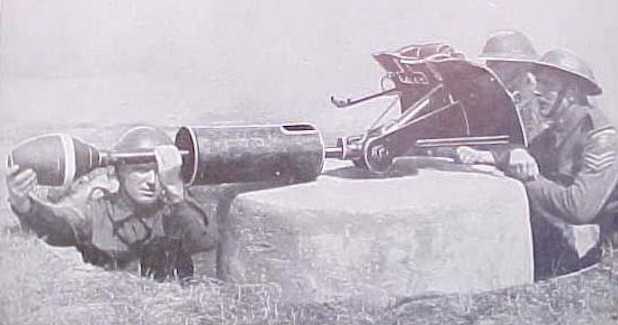 a substantial concrete base with a stainless steel pivot
on top to rest the weapon. Several years ago I recall
that a person on the Mount had found a concrete emplacement
in his garden and he was anxious to know all about it.
It was soon identified. The concrete base for our local
weapon was positioned at the junction of
Berwick Road
and the lane to the West Mid Showground with the intention
of attacking tanks or vehicles advancing on Shrewsbury
from the Baschurch direction.
a substantial concrete base with a stainless steel pivot
on top to rest the weapon. Several years ago I recall
that a person on the Mount had found a concrete emplacement
in his garden and he was anxious to know all about it.
It was soon identified. The concrete base for our local
weapon was positioned at the junction of
Berwick Road
and the lane to the West Mid Showground with the intention
of attacking tanks or vehicles advancing on Shrewsbury
from the Baschurch direction.
The base disappeared
some years ago but one still exists off the
Ellesmere
Road in Greenfields. It is not easy to spot because it
has become ivy-covered over the past six decades. It was
said at the time that the Greenfields emplacement was
selected to patronise Brigadier Dann who was the supreme
Commander of the Shropshire Home Guard and who lived in
a large house about two hundred yards distant towards
the Moveage.
We were only issued
with three missiles, so I guess it gave some indication
of our life expectancy. I did query how I was expected
to transport such a heavy weapon to its site and it was
suggested I used my father's tradesman's cycle with the
square carrier on the front. It was to be hoped that the
invaders did not come when it was suffering from one of
its frequent punctures!
The Corporation
Lane sector had four reinforced trenches for observation
and defence, from the wood at Round Hill Green to the
railway line at Coton Grange. I can recall the exact siting
of the trenches, but it is many years since I visited
them. Our sector was rather strategic because the main
GWR railway line ran along the Eastern boundary with marshalling
yards either side.
Practical Training
was always a popular activity with trips to the
Red Hill
Grenade Range, Coleham Drill Hall .22 range, Shelton Rough
Rifle Range and the Wrekin Range. Field Training was taken
at Church Stretton where we roughed it in a large white
house on the Cardington Road. Regular soldiers from
Copthorne
Barracks were the instructors. Whilst the officers were
in the house we were given a taste of military austerity
in several huts of the Nissen type. I can recall a dodgy
exercise in Ashes Valley where regular soldiers were firing
live ammunition over our heads. We were carrying Sten
Guns and at one stage we had to fire at full size cutouts
from cardboard. The Sten Gun was well known to be a temperamental
weapon and one was taught to hold the magazine with the
left hand when firing. If not there was the danger that
one would get one's fingers in the ejection opening where
the bullet cases were discharged. The fellow next to me
had not heeded the warning and had shouted to me he had
lost the end of his little finger. After such blood and
swearing he was hurried to the Medical Tent. I never saw
him or his missing finger again.
Despite the national anxiety we
were all going through we could raise a smile and training
sessions were often followed by a little 'socialising'
in either the Woodman or the
Royal Oak on
Coton Hill -
even though I was slightly under age".
Mr. Rowlands can now remember
only a few of his colleagues in the Corporation Lane
platoon. Several later distinguished themselves in the regular
forces. Freddie Sayce of
Coton Hill was killed in Normandy,
and a soldier called Holborn of
Coton Crescent was commissioned
and decorated while serving with the K.O.S.B. at Arnhem.
Jock MacLaren was also commissioned,
Ted Amos served with
the R.A.S.C., and Richard Smith of
Butcher Row in the Oxford
and Bucks Light Infantry.
Inevitably His Majesty caught
up with Mr. Rowlands in 1944 by sending him the customary
brown envelope, the contents of which directed him to report
to the Buffs
(Royal East Kent Regiment) depot in Canterbury.
"I have
never been able to fathom out why I was not routed to the
K.S.L.I. Barracks at Copthorne. At least I survived the
Flying Bombs raining down in Kent - but that is another
story".
Glyn Rowlands's life in
the Shrewsbury Home Guard was over.
ADDITIONAL
BACKGROUND INFORMATION
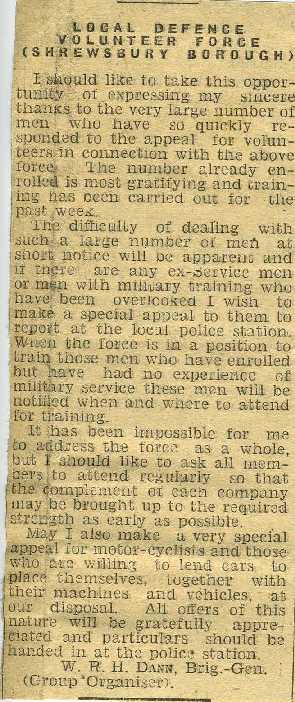
This late May 1940 cutting
from a local newspaper gives an indication of the promptness
and the scale of the response to the call to arms.
Brigadier W.R.H. Dann
D.S.O. was a retired regular soldier who between the wars
had been a member of the Bedfordshire Regiment. He had been
commissioned well before the Great War and his participation
in May 1917 in the Second Battle of Bullecourt as a Lt.
Col. in the Royal Fusiliers had brought him his award.
The nationwide Defence
of Britain Project (1995-2002) recorded about 30 examples
of surviving defensive structures of various types in and
around Shrewsbury, ranging in size from spigot mortar bases,
including that at Greenfields mentioned above and one or
two others, through larger structures such as pill boxes
and trenches, right up to complete airfields. This
information is available online. If you wish to see it
Click
here and insert ...Shrewsbury ... in the "Place" box
of the Enquiry Form.
(You will leave this site).
Glyn Rowlands died in
January 2019. Toby Neal wrote a futher article in the
Shropshire Star about him at that time which tells us a
little more about the man and his life.
|
.... And as a teenager Glyn Rowlands was one of
Shrewsbury's Home Guard defenders. In true Home
Guard fashion, had German panzers rolled towards
the county town he would have grabbed a
Blacker
Bombard anti-tank weapon, loaded it up in the
square carrier on the front of his fatherís
tradesman's bicycle, and pedalled to its firing
position at the junction of Berwick Road....
Born at Berriew on
July 16, 1926, his parents rented
Coton Hill Farm,
off Corporation Lane, Shrewsbury, from the
mid-1930s. Aged 16, he joined the Home Guard, and
had many anecdotes about those days.
He served in E
Company, the Coton Hill Company which covered the
patch from Shelton Rough in the west, to
Hencote in the north east.The
Corporation Lane platoon was
based at Coton Hill Farm, his home at the time.
Outbuildings and the farmhouse were used to store
materials, arms and ammunition.
He was called up
into the Army in 1944 and rose to the rank of
Company Sergeant Major. Daughter Rhian Piprell
said:
"On demob Dad returned to Shrewsbury and
joined the Shropshire Constabulary. I have a
photograph of the contingent of Shrewsbury
Constabulary that went to the Coronation and stood
in the pouring rain in Downing Street. Dad said he
was the last living member of the contingent. He
had some wonderful stories of being on the beat in
Shrewsbury in the 1950s. In the mid-1950s
Dad left
the police service and became an education welfare
officer working from the Shirehall. We lived for a
time in Church Preen before moving back to
Bayston
Hill and Copthorne in the 1960s. Mum Janet was an
SRN in Shrewsbury. She trained at the Royal Salop
Infirmary and they met at a dance".
In the
late 1960s Glyn moved to Wigan as chief education
welfare officer before taking a similar role in
East Sussex before retiring to Bala, later living
in Welshpool and Shrewsbury. His daughter
continues:"While in
Bala he was
known fondly as 'Glyn Fuchsia' owing to his
passion for growing fuchsias. He would give talks
on them. Throughout his life he was a passionate
gardener. To save money for their first house dad
grew chrysanthemums and sold them in Shrewsbury
market where my grandmother had a stall".
Glyn is
survived by Rhian, his sister Hilda Ralphs from
Barrowsbridge in Lancashire, and brother Wynn
Rowlands of Arddleen.
|
Quotations © Shropshire Star, Toby Neal 2006-2020
Personal image and other information © The Rowlands
Family 2006-2020
ACKNOWLEDGEMENTS
Grateful acknowledgement is made
to the Rowlands family, the Shropshire Star, Toby Neal,
Linda Dennis and the
Remember Britain's Home Guard
Facebook page.
In memory of
Glyn Rowlands
and all his comrades
in
1st Salop (Shrewsbury)
Battalion
Home Guard
|
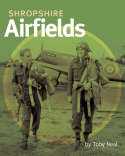 Toby
Neal has written many articles on Shropshire local history
and a number of books. Those of the latter currently available
are "Shropshire Airfields" and "Owd Jockeys
At War: The Dawley News 1915-1916". Both are available
from booksellers or direct from Langrish Caiger Publications,
PO Box 1916, Telford, Shropshire TF7 5XZ . Toby
Neal has written many articles on Shropshire local history
and a number of books. Those of the latter currently available
are "Shropshire Airfields" and "Owd Jockeys
At War: The Dawley News 1915-1916". Both are available
from booksellers or direct from Langrish Caiger Publications,
PO Box 1916, Telford, Shropshire TF7 5XZ .
Further information about the Shrewsbury Home Guard will be welcomed. If you can help, please use
Feedback .
For other references
to
Shrewsbury, please select
the Shropshire Page link below.
|